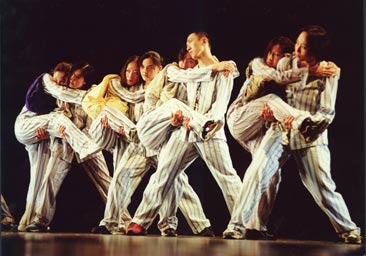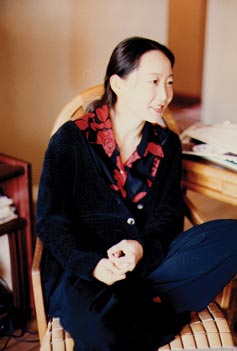| 中国现代舞--传统与新潮的完美融合 |
| http://www.sina.com.cn 2004/05/25 14:53 中国周刊 |
While traditional dances still abound in China at academies and social clubs, there is more to dance in the Middle Kingdom these days than fans and acrobatics. The first official modern dance company was founded in China's southern Guangdong province in 1992. Since then, a small number of other government-approved as well as independent companies have come about, while members from the original company have spread throughout China and to such countries as Germany, Japan and the United States. For those who might not be familiar, modern dance is a style that developed in the early 20th century by dancer/choreographers like Isadora Duncan and Martha Graham in the United States and Mary Wigman in Germany. These artistic pioneers wanted to free themselves from the rigidity of ballet by exploring other ways of moving the body and creating dances. Over the years, modern dance in the West has developed to encompass many different forms and styles. These range from more conservative varieties that still closely resemble ballet, to quite avant-garde forms that seem more like theater or performance art than pure dance. Individuals from China studied modern dance in Japan and the United States as early as the 1920s and 30s, and then returned to China to teach or start their own dance companies. During the Cultural Revolution, modern dance, which was considered a foreign import, became associated with American imperialism and was prohibited by the Central Government until 1980. When China once again began interacting with the outside world in the 1980s, modern dance re-debuted on Chinese stages - and this time, it's here to stay. It has not been easy. China's two official modern dance companies, the Guangzhou Experimental Modern Dance Company and the Beijing Modern Dance Company, are better known by audiences in Europe and the United States than they are here in China. Older Chinese audiences prefer to see familiar things, such as folk dance and Peking opera, rather than this strange new art form, while younger audiences are lured away by DVDs. Students interested in learning modern dance struggle to find opportunities. Even at prestigious schools like the Beijing Dance Academy, there are no modern dance departments or modern dance majors. Instead, a few modern dance classes are offered within other departments. Moreover, the academies rarely invite teachers from abroad so students have only one or two people and styles to learn from. They therefore receive a very limited view of an extremely broad art form. There are people working to change all of that. I will introduce you to four of them. They are the Mother and Father of modern dance in China, the Warrior Patriot teaching at the Beijing Dance Academy, and the Free Spirit who founded the first independent dance-theater company in China. Each has contributed in their own unique ways to modern dance in China, helping the art form to develop in different directions. The Mother and the Father Without Yang Meiqi and Willy Tsao, there may not be modern dance in China today. Their early professional collaboration and later individual efforts created and fostered the two official modern dance companies in China. In 1987, Yang Meiqi, then principal of the Guangdong Dance Academy, set up a four-year modern dance training program with support from the Provincial Cultural Bureau, the Asian Cultural Council and the American Dance Festival. Some of the best dancers from song and dance troupes all over China, most of whom had never heard of modern dance, were recruited to join. Dance professionals from the United States and Europe came for three months at a time to teach at the program. Upon graduation, with approval from the Chinese government, some students remained and formed the Guangdong Experimental Modern Dance Company, China's first official modern dance company. "Our troupe was a formal government organization, so it had certain responsibilities," explains Yang. "Every year we gave 40 regular performances and 20 performances in poor mountain areas. We also went to colleges to do educational demonstrations." Yang invited Willy Tsao, founder of the first modern dance company in Hong Kong, to come to Guangzhou to be artistic director of her new company. In 1998, Tsao moved to Beijing to take over as artistic director of the Beijing Modern Dance Company, which had been founded in 1995 by Jin Xing, a graduate of Yang's program. Tsao has a business degree from the United States where he also studied modern dance. Under his leadership and generous personal contributions, both the Guangdong and Beijing Modern Dance Companies have toured throughout the world and gained international renown. Tsao continues to pursue his goal of developing dancer-choreographers. He does not impose his own style on the company members, but rather encourages them to develop their own works to perform. In June of 2004, another group of 28 students will graduate from Yang's second Guangdong modern dance program. These students will not form a company but rather look for jobs in already established companies, or as teachers at various university dance programs. Says Yang, "These students are the seeds from which will grow the future of modern dance in China."
The Warrior Patriot Not all of the students who graduated from the original four-year program remained to be part of the company. One of the group's most talented dancers and choreographers, Wang Mei, had to return to her work unit at the Beijing Dance Academy. There, with Guangdong classmate Zhang Shouhe, Wang Mei helped set up the modern dance program under the choreography department, where she still teaches today. In some respects, Wang Mei shares similar views with Yang Meiqi and Willy Tsao. She views education as the way to develop students' creativity and open up their minds. But while Yang and Tsao want to expose their dancers to the outside world, Wang Mei wants them to turn inwards. She explains, "When I came back from Guangzhou, I felt that China was a very backwards country, not just economically but also culturally. How did we come to the point where we had to study things like modern dance from foreigners? I had a problem with this. So I always tell my students, 'You can take the modern dance technique you've learned from foreigners and make it part of your life, but the content of your dances still has to come from within you.'" Although she encourages personal exploration in her students, she nevertheless demands absolute precision when they are learning her choreography. One student warns, "Every count has a movement and if you are even a split second off, she will be furious." Wang demands much of her students only because she demands even more of herself. Explains another student, "Wang laoshi has taught me more about life, art, and China than anyone else. She is creating something totally new, a unique form of Chinese modern dance." Wang's choreography draws on everything from love stories in ancient Chinese literature to every day gestures you see in the Chinese countryside. But as for now, Wang has no desire to form her own company or represent her country on international stages, because "my goal is not to make great contributions to the field of dance or the Chinese national cause, but merely to satisfy myself." The Free Spirit Although her company, the Living Dance Studio, performs frequently throughout Europe and the United States, Wen Hui has no intention of ever leaving China permanently. "I do not feel as inspired in other countries," she says. "China never ceases to inspire me." This Yunnan native trained in folkdance first encountered modern dance in the United States when she was visiting with her partner, independent filmmaker Wu Wenguang. A choreographer invited her to participate in a dance festival, and each time Wen asked if she could incorporate something new into her solo, the choreographer's response was, "No problem!" Can I flood the stage with water? No problem! Can I hang laundry all over the chairs in the audience? No problem! Can I invite people who are not professional dancers to get on stage with me? No problem! Wen Hui has adopted this open, "no problem" attitude both in her pieces and her style of creating them. She almost always collaborates with live musicians, filmmakers, visual artists, writers, actors and dancers. She and filmmaker Wu founded the Living Dance Studio in 1994, China's first independent dance-theater company. All the performers in the company have other jobs and meet in their spare time to rehearse. Their performances tend to happen in smaller spaces and audiences learn about them through word of mouth. The Living Dance Studio draws on issues in Chinese society for their pieces, which have ranged in content from a collaboration between 8 dancers and 30 migrant workers performing in an condemned warehouse in downtown Beijing to an exploration of female body images in contemporary China. As scholar Zi Huayun points out in his article The Flying Apsaras of the Dunhuang Caves and Flying Apsaras, "Every branch of the Chinese arts developed by absorbing and assimilating 'foreign' elements, while maintaining the indigenous culture as a foundation."1 Dancers in China today are using the new tool of modern dance as a way to explore and try to understand a rapidly changing society, and their places - as individuals and as Chinese citizens - within its structure. In the process, they are creating a new idiom of modern dance, one that is distinctively modern and uniquely Chinese. 1 Zi Huanyun, "The Flying Apsaras of the Dunhuang Caves and Flying Apsaras," World Dance '96: New Dance From Old Cultures (Green Mill Papers, 1996) 89 by Alison Mara Friedman (方美昂) |
| 【英语学习论坛】【评论】【大 中 小】【打印】【关闭】 |

